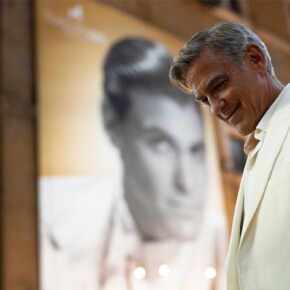Bono struts his stuff in Stories Of Surrender
Mike Finnerty 30 May 2025
90 minutes of Bono doing a one-man stage show is someone’s idea of heaven, hell, or purgatory.
Bono: Stories Of Surrender documents a 2023 show in New York City where Bono fleshes out or expands upon stories told in the 2022 book, Surrender: 40 Songs, One Story.
As the man himself puts it, it’s “the tall tales of a short rockstar,” and it is the ultimate tribute to Bono the brand that he makes it entertaining to watch.
If you received the book for Christmas in 2022 and thumbed through it before never picking it back up again, the book follows Bono as he tells various stories of his life.
The book, and subsequently the film, has Bono recall everything from how U2 met at a Northside school in the 1970s, Bono’s relationship with his father, his charity work and a screwball comedy-esque encounter with Pavarotti.
Released last week on Apple TV+ (the streaming service that prioritises quality over quantity, take notes, Netflix!) Bono comes very close to having a moment of self-awareness, and that makes it worth the price of admission alone.
The hit against Bono is that he is the living embodiment of the out-of-touch rockstar; it makes it somewhat surprising that Bono is in on the joke here.
Australian director Andrew Dominik is the man who has achieved the impossible; he managed to get Bono to drop the ego for a minute.
Bono outright says at one stage that he is a hypocrite – but adds a disclaimer that he isn’t one when it comes to charity and has put his money where his mouth is.
In the run-up to the release of this film, former U2 producer Brian Eno said he was donating his royalties from conducting the Windows 95 start-up sound to people trying to flee the ongoing war in Gaza.
In the text of this film, Bono explains he has the power to talk to people who control the purse strings, and are the ones who control the financial stakes of developing nations.
As we wrote in last week’s edition, this is the core of the Bono paradox; should he be literally putting his money down on the barrel, or should he exploit the fact that he has the ear of the people who really control the purse strings?
What makes this film so interesting is that Bono is aware of the criticisms you undoubtedly have about him.
In fact, the experiment kind of breaks down when it has to be about the music.
1988’s Rattle and Hum was a combination of live performance intercut with tour footage or the band rehearsing; the three elements add up to present this snapshot of U2 at their zenith.
In 2025, it is less interesting to see Bono perform reworked versions of his old hits.
The film is like a therapy session; just when you feel you are on the verge of a breakthrough, the hour is up.
Of course, we also noted last week that Bono is more famous these days for being a public figure than a rock star, so it’s understandable he belts out some tunes to remind people of how he pays the bills.
Dominik is an accomplished director of musicians – he has done extensive work with Nick Cave, and you get the sense that Bono wants some of that sheen – but it doesn’t quite work when it’s Bono without the grounding a chiming guitar or drums gives him.
It almost feels strange to criticise a music-themed film for being more interesting when it’s one guy talking instead of singing, but it’s 2025 after all, the year where nothing makes sense.
There are inherent limitations to the “one-man Bono stage show” conceit, and the film quickly runs up against it.
It isn’t impossible to make one man monologuing to a relatively unseen audience interesting – Jonathan Demme did that when he filmed Spalding Gray in Swimming To Cambodia in 1987 – and Dominik tries his best to work around combining the mediums of theatre and film.
It’s more of a noble failure, in that regard; it gets points for trying to make the viewer feel like they are in the room with Bono, but it also has an editing and tonal style it can’t quite nail down.
In one segment, Bono is doing black box theatre or prop work with tables and chairs, in another, we see flashing stage lights juxtaposed against the black and white cinematography to punctuate a point.
The moody black and white cinematography comes to us from Oscar-winning DP Erik Messerschmidt, now best known for his work with David Fincher, Michael Mann and Ridley Scott.
Messerschmidt won his Oscar for 2020’s Mank, managing to make black and white, 1940s Hollywood look as luxurious and vivid as its heyday.
The choice to shoot the film in black and white feels like a stylistic choice and let Bono, the man, be the star of the show.
It is indeed striking to see one of the world’s most famous people, shot in extreme close-up, in crisp black and white.
U2 superfans will be aware that Bono very nearly became a Hollywood star – in 1995, a planned cameo in Batman Forever didn’t come together, and he was nearly cast to star alongside Ralph Fiennes and Juliette Lewis in the Kathryn Bigelow masterpiece, Strange Days.
There is an inherent theatricality to Bono that makes him appealing to watch, even when he isn’t in rock star mode.
Bono doesn’t quite go full McPhisto here (as hilarious as that would be), but he leans into the cheeky, devil-may-care attitude that has made him a global star for all these years.
For fans of the man and those who read the book, the film is still worth checking out, if only to get a glimpse of Bono from the comfort of your living room.
For people who scoff whenever With Or Without You comes on the radio and rolls their eyes at the idea of Bono strutting around the stage for 90 minutes, this film might not be for you.
It isn’t a film you can imagine watching more than once, like Rattle and Hum or Stop Making Sense, but nonetheless, it’s a solid entry into the music documentary canon.











